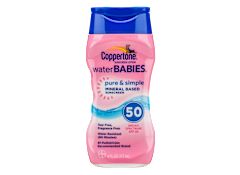

Cvs thinkbaby sunscreen skin#
UVA is linked to wrinkles and uneven skin tone and the more harmful forms of skin cancer. And given that most folks not only don’t apply enough to reach the SPF number or don’t reapply they are receiving far less protection than they understand.Īlso, SPF doesn’t provide you with any insight into UVA protection. The ultra-high SPF numbers have caused people to spend far more time outside than they should be. Formulated as a physical sunscreen, the mineral sun cream works immediately upon application, and is easy to apply, absorbing quickly into the skin without feeling uncomfortably oily or sticky. SPF is just a measure of UVB (Think “B” burn). Produced in the USA, Thinkbaby mineral-based sunscreen protects babies’ and kids’ sensitive skin, with broad UVA/UVB coverage from 20 non-nano Zinc Oxide. This rule is still pending as the writing of this and has not been made into law. The FDA weighed in on this issue in 2019 and has proposed a limit of SPF 60+. Basically, you’re getting a marginal increase in protection. SPF 30 provides 97% protection from UVB and SPF 100 provides 99% coverage for UVB. EWG’s Skin Deep® is a cosmetics database that rates products based on potential hazards and health concerns.įirst, consumers have been led to believe that ultra-high SPF numbers like 70 and 100 provide much more protection than SPF 30. See how Think ’s mineral sun s creen compares to other similar brands : To help you make the best choices when choosing sun care, we recommend comparing your sunscreen options on EWG’s Skin Deep®. EWG’s Skin Deep® is a cosmetics database that rates products based on potential hazards and health concerns. To help you make the best choices when choosing sun care, we recommend comparing your sunscreen options on EWG’s Skin Deep®. We look to scientific research and data to ensure our products provide effective sun protection without causing harm to human and animal health or the environment. W hile other brands are slow to make formulas based on federal policy change s, we’re not waiting. While there is some regulation of sunscreen by the FDA, it is not currently thorough enoug h to ensure ingredients are safe and effective.
Cvs thinkbaby sunscreen free#
These results are important because they help each of us be aware of possible exposure to benzene from sunscreen products.įortunately, most of the sunscreens tested were found to be safe and completely free of benzene contamination (73%).Make Safer Sunscreen Choices with EWG’s Skin Deep ® Ratings Valisure’s testing showed that several spray sunscreens have higher levels of benzene than the gels, lotions, and creams.

However, some sunscreen products contain the carcinogen, benzene. Sunscreens helps protect us from skin cancer. Tested sunscreens that were found to have zero benzene can be found in this pdf: Bare Republic Mineral Spray Vanilla Coconut SPF 50 Get a thoughtful sunscreen formula with the Thinkbaby Safe Sunscreen SPF 50+ 3oz.Sunscreens that you’ll likely recognize that did not contain benzene include: No benzene was found in 273 (73%) of the products tested from 66 different brands.
Cvs thinkbaby sunscreen pdf#
To review the full list of the sunscreens that were found to have detectable levels of benzene, see Tables 2 and 3 in this pdf document (pages 12-15): Thirty-eight products from seventeen brands contained less than 0.1 ppm of benzene. A level less than 2 ppm is consistent with the FDA’s recommendations. Twenty-six products from eight different brands contained levels of benzene between 0.11 – 1.99 ppm. Im sure you recognize most of these brands. These levels (greater than 2 ppm) exceed the FDA’s safety limits. Coppertone Water Babies Sunscreen Lotion, SPF 70+ CVS Age Renewal Firming & Hydrating Moisturizer, SPF 30. Health contained between 2.8 – 6.3 ppm of benzene. Valisure did not test any powder sunscreens.įourteen products from four different companies: Sun Bum, Neutrogena, Fruit of the Earth, and CVS Both chemical and mineral-based formulations of some products were found to have benzene. Some contained up to 3 times the recommended FDA allowance.īenzene contamination was found in sprays, lotions, and gels.

They found that 27% of samples had detectable levels of benzene.


 0 kommentar(er)
0 kommentar(er)
